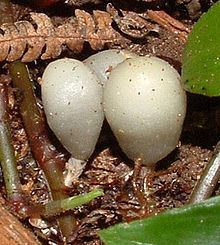Kingdom Fungi Class Agaricomycetes | Division Basidiomycota Order Agaricales Rank Genus | |
 | ||
Similar Psilocybe weraroa, Leratiomyces erythrocephalus, Leratiomyces, Leratiomyces ceres, Cortinarius porphyroideus | ||
Weraroa marae
Weraroa is a genus of mushrooms in the Strophariaceae family. The genus was initially described by mycologist Rolf Singer in 1958 to accommodate the single species Secotium novae-zelandiae reported by Gordon Herriott Cunningham in 1924. It has been suggested that the genus may represent an intermediary evolutionary stage between an hypogeous (underground) ancestor and the related epigeous (above ground) genus Stropharia.
Contents
- Weraroa marae
- Weraroa cricket club levin new zealand 90th part 1
- Macroscopic
- Microscopic
- Habitat and distribution
- Species
- References
Weraroa cricket club levin new zealand 90th part 1
Macroscopic
Weraroa species are secotioid fungi, meaning that the margin of the pileus never breaks free of the stipe, making them resemble somewhat a pouch on the end of a stem, or stalked-puffball. The peridium (outer wall), which at maturity is glutinous, may range in shape from fusoid to spherical to ovoid or ellipsoid.
The gleba consists of elongated loculi that are various shades of brown. The stipe may also be glutinous, and is continuous with a columella reaching and merging with the upper peridium, often with a thin veil-like structure that joins the edge of the peridium with the top of the stipe. The context is fleshy and may be gelatinous in the outer portion of the peridium.
Cunningham was first to report that the mushroom takes a long time to mature, and specimens can also persist for long times.
Microscopic
Spores are typically from 10–20 µm in diameter, ellipsoid in shape, smooth, and pigmented ochre to brownish. The basidia (usually 4-spored) often envelop their sterigmata in gastroid-like fashion (i.e., enclosed), and may be narrower in the middle with a broader base. Chrysocystidium are present on the hymenium, on the sterile surfaces of young specimens, and as endocystidia.
Habitat and distribution
Species are usually found in rainforests or wet grasslands, growing on the ground or on wood; species of Weraroa have been found in New Zealand and the United States.
Species
The species formerly known as Weraroa cucculata (Seaver & Shope) and W. erythrocephala (Tul. & C. Tul) Singer & A.H. Sm. (1958) were recently transferred out of this genus into Leratiomyces. This phylogenetic research also demonstrated the close relationship between the type species W. novae-zelandiae to the hallucinogenic blue-staining group of Psilocybe, particularly P. subaeruginosa. Because W. novae-zelandiae is the type species for Weraroa, this information would suggest that the blue-staining Psilocybes should be transferred into this genus. However, the generic name Psilocybe was conserved (Redhead et al. 2007) with the type species Psilocybe semilanceata. Weraroa novae-zelendiae is, therefore, classified as Psilocybe under the new name (nomen novum) Psilocybe weraroa Borovička, Oborník & Noordel. (Borovička et al. 2011).
